We’ve arrived in the middle of a special weather advisory: downpours, gusting winds, the works. The unusual, unseasonal storm has pummeled the islands for days, and the dive staff have developed a sense of humor about the situation. One wannabe comedian cracks a joke as we lug our gear to the boat: “Sometimes they’ll name a typhoon in retrospect. This might qualify.” We respond gamely with the best laughs we can muster. The rain is coming down hard, and I put on my mask for the skiff ride.
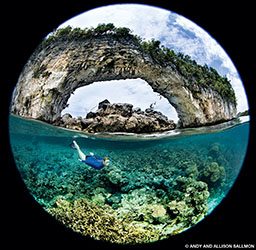
As we motor through the iconic rock islands it doesn’t take long for admiration to take hold. Palau is otherworldly beautiful. Even in the rain, even through a misty mask, the colors grab me and won’t let go. It’s as if a benevolent giant threw a handful of emerald-green marbles onto an impossibly turquoise backdrop. Underwater, the vivid splendor is magnified: The offshore waters are crystalline blue, the lagoon a rich aqua. Neon soft corals and anemones pop, while silvery barracudas and jacks shimmer. Sharks and mantas exude gravitas with their crisp monotones.
Getting Hooked
Our guide appraises us critically as we motor toward our first dive site. “Everyone got a reef hook?” he asks. Heads nod. He briefs us to ensure we are comfortable deploying the hooks (like barbless fishing hooks attached to strong nylon cord) and then adjusting our buoyancy to use them safely. I glance down at my hook, which has been stuffed in a buoyancy compensator (BC) pocket since 2010. I can’t recall such emphasis being placed on reef hooks anywhere else I’ve dived, but Palau is famous for merciless currents, and I have the uneasy feeling I’m about to develop a new level of respect for the ocean.

We descend at Siaes Corner just as an aggregation of orangespine unicornfish streams by, a black-and-orange blur that turns the water column darker than the sky. The current doesn’t allow us to view the spectacle for long, however. It shuttles us rapidly past an anthia-clouded, coral-covered slope to deposit us on the site’s namesake, a rocky, rubbly elbow at 40 feet. The water brutally whips past, and at our guide’s signal we hook in to watch silvertip and gray reef sharks hunting in the blue. I fly above the reef like a kite in the wind, and the sensation is glorious.
Back on the surface, our guide looks at the boat captain and nods meaningfully, prompting another rain-pelting ride through a series of islands and channels. We must have passed inspection. When we arrive at our destination, the famed Blue Corner, the excitement on the boat is palpable. The mooring line pulses in the swell and the current, indicating that we’re in for a hell of a ride. When we hit the water there’s no time for contemplation; it’s mere seconds before we reach the plateau that’s one of the best-known dive sites on the planet. We hook in at the reef’s edge at 55 feet, dig our teeth into our mouthpieces and do our best to manage our cameras in the rip-roaring flow.
Dozens of gray reef sharks parade past just feet from us, stacked up in the current and completely indifferent to our presence. Dogtooth tuna, also key players in the show, seem more voracious than the sharks, their gluttonous tendencies made clear by occasional, echoing THWACKs that denote the unfortunate demises of nearby jacks. One by one, we release our hooks and drift over the plateau to check out the second-tier wildlife attractions: eagle rays, a school of chevron barracuda, a leaf scorpionfish miraculously holding position and sweetlips angling for a cleaning.
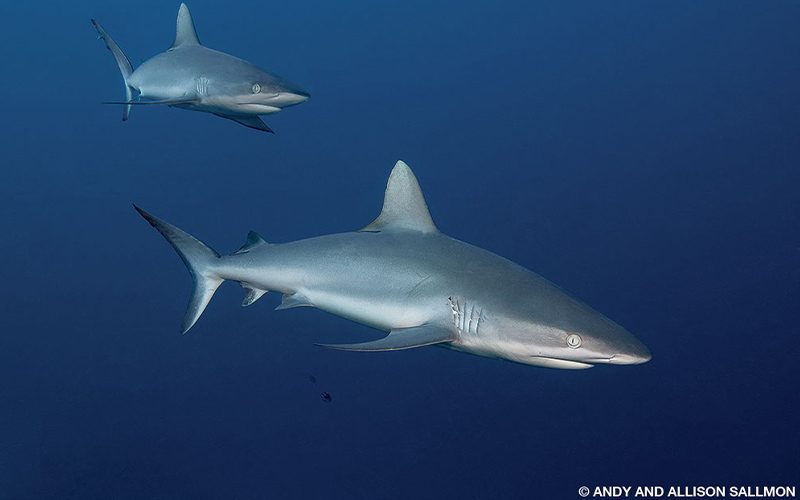
We’re happy to discover that Palau also has plenty of hook-optional sites. At Ulong Channel we explore a towering hard coral wall before arriving at a shallow passageway. The current here feels like child’s play after Blue Corner, and we float past patrolling gray reef sharks and sleeping whitetips, a large ball of jacks and streams of bigeye, bright against a sandy backdrop.
German Channel simply requires that we hunker down next to a rocky cleaning station at 65 feet and wait for the inevitable procession of mantas and reef sharks. Mellowest of all is Dexter’s Wall, a sloping, anemone-studded dropoff that reaches to within inches of the surface. Thanks to nearby nesting areas, the site is riddled with turtles. A pretty hawksbill, descending from the surface, gets a glimpse of her reflection in my port and makes chase, doggedly pursuing her glassy twin from one end of the reef to the other. And here, as with every other offshore reef in Palau, all you have to do to view a gray reef shark is glance into the blue.
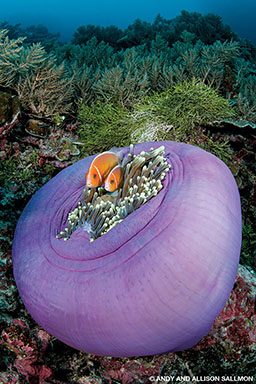
A Sunken Past
Surrounded by the splendor of these islands, it’s nearly impossible to comprehend the gory battles that took place here during World War II. But as the site of one of Japan’s strongest and most critically located naval bases, Palau was an irresistible target for the United States. Operation Desecrate 1, one of the major battles in Palau, consisted of a merciless, 48-hour-long air raid that killed thousands of soldiers, sank or damaged 36 Japanese ships and confirmed Japan’s wartime shift to a defensive posture.
The shelter of Koror’s Malakal Harbor is filled with historically significant shipwrecks, though most divers visiting Palau never view them. If there’s one positive aspect to our visit being plagued by bad weather, it’s that we have a need to stay in the harbor — and a rare opportunity to explore these wrecks.
We’re indoctrinated on the Helmet Wreck, named for the stacks of helmets visible in the ship’s hold. I’m not a war buff, but even I recognize the scene in front of me: a sunken transport vessel with its hull splayed open and depth charges spilling from the wound. Discovered in 1990, few details are known about the ship’s demise (though the gaping hole in its starboard side confirms the cause). The 189-foot-long, artifact-packed structure is upright and rests in 45 to 110 feet of water, which has made it a favorite of wreck divers. We carefully inspect the depth charges and helmets before moving forward, passing the compass that sits on the bridge and circling the bow. Before ascending we take our time looking over the items that rest near the stern gun: boxes of detonators and bottles, a gas mask and dishes.
Palau’s violent history is again made clear when we dive the IJN Iro. This Japanese oil tanker was bombed multiple times while at anchor, which killed 50 crew members, including the captain. The Iro is a monstrous upright structure, 470 feet long, and the persistent rain has turned the water column murky. With the main deck lying at a shadowy 90 feet, I can’t help feeling spooked as the huge stern gun comes into view. The wooden structures that once shielded the platform are gone, leaving behind an eerily skeletal framework. There are no other divers around us, and I feel the need to look behind me, paranoia taking hold as a result of narcosis or thoughts of bloody war. When we ascend toward the aft mast and then the towering goalposts amidships, I feel my nerves loosen. The posts, carpeted by anemones that provide homes for dozens of tomato anemonefish, are reeflike enough to impart familiarity and relief.
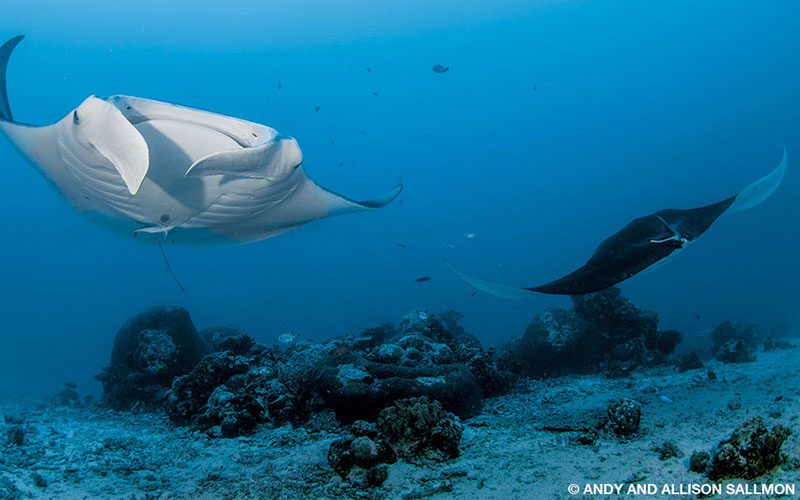
The Chuyo Maru, another ship that was bombed at anchor, is a short ride away. This 285-foot-long freighter rests upright at 115 feet, and though smaller and shallower than the Iro, it’s no less fascinating. We explore the stern gun and nearby ammunition boxes, each covered with a colorful combination of sponge and black coral. Meanwhile, the tech divers in our group beeline straight for the silty, overhead comfort of Chuyo’s engine room, its incredibly intact components famous among wreck enthusiasts the world over. We rendezvous at the upright kingposts, watching together in admiration as anthias rise from the abundant hard coral.
Perhaps the most commonly visited war relic here is a seaplane (thought to be sunk while stationary) commonly called the Jake. Resting in a pristine coral garden in 45 feet of water, the plane’s nose is layered with hard corals and sponge, and wire coral pokes from the cockpit and wings. The sun has made a brief appearance during our dive, and in the late afternoon rays, the scene is oddly peaceful.
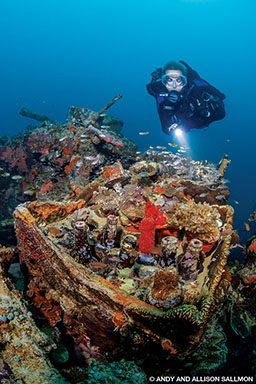
Sundown and Sunup
Our time in Palau is dwindling by the time we’ve conjured the motivation to do a night dive. With the reefs and wrecks and schooling fish and sharks, I’ve found it hard to get enthusiastic about being tethered under a skiff over nothingness. It takes a minute to get accustomed to it; a mild current is running (no surprise there), giving us the strange sensation that we’re drifting through space. That impression is furthered by the alien beings that pass by at regular intervals. At first glance they are nothing special, just specks of crud in the water, but my perception changes when I aim my light’s beam and look closely. How have I missed this before? The nighttime open ocean, it turns out, is filled with gleaming, darting babies, the tiniest of which are protected by transparency — this is the basis of blackwater diving.
I forget about the deep water and concentrate as our guide points out various creatures to me. My poor camera lens struggles to focus, as do my inexperienced and aging eyes. After 30 frustrating minutes, I decide to stick with older — and blessedly pigmented — creatures, making exceptions for squid and tiny jellyfish. Hours pass in a psychedelic blur, and when I surface under a star-filled sky, I feel oddly tranquil (despite the certainty that this was one of the least-productive photographic dives of my life). It’s a moment of weakness, so when the guide asks me how I’d feel about doing a spawning dive the next morning, I’m easy prey.
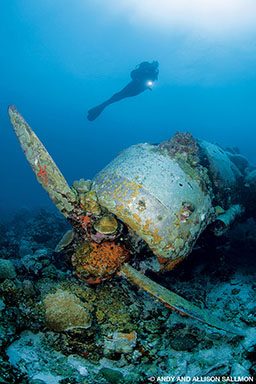
Serenity and niceties are in short supply when my alarm goes off at 4:45 a.m., and our small group of suckers staggers groggily toward the coffee, grunts at one another and blearily boards the skiff we disembarked only hours before. We make a short run to an unnamed site, gear up and drowsily roll into the dark ocean, the moonless sky having clouded over once again. Below us we can make out dozens, then hundreds of bumphead parrotfish pacing back and forth over the shallow reef. This spectacle alone is almost worth the price of admission — each fish is more than 4 feet long, and because they’re a vulnerable and heavily overfished species, viewing hundreds of them at once is almost more than my unfocused brain can handle. But I know that something more is happening, something big.
We follow the mass of parrotfish to deeper water, where they meet up with masses and masses of other parrotfish. Thousands of bumpheads now mill around below us as we desperately monitor our depth and try to decide how best to photograph this huge gathering of fish with almost no ambient light. Suddenly, a cluster of fish bolts upward into the water column, a female releasing her eggs, surrounded by a throng of males releasing sperm. A fat bull shark plows toward them, missing the amorous mob by inches. The bumpheads continue to swim, and we follow them doggedly, breathing away our air supplies at an alarming rate. As a dim morning light penetrates the water, the fish rise and fall again and again and again, the ocean misty with a new generation.
How to Dive It
The Republic of Palau, located in the Western Pacific, comprises more than 300 islands and forms the western chain of Micronesia’s Caroline Islands. In 2015 Palau established a marine reserve that protects 193,000 square miles of ocean — one of the largest marine sanctuaries in the world.
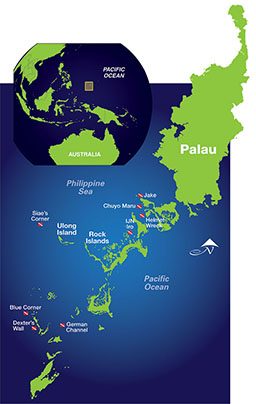
Getting there: Multiple airlines travel to Koror, Palau’s most populous island. Americans can enter Palau for up to a year without a visa, while citizens of many European Union countries can stay for up to 90 days in any 180-day period. Citizens of most other countries can obtain a 30-day visa upon arrival.
Seasons: Water temperatures in Palau are in the low- to mid-80s (°F) year-round. A 3 mm full wetsuit is recommended. The dry season, thought to coincide with the best diving conditions, spans from November to May, though rain showers are common year-round.
Conditions: While some sites are fine for novice divers, much of the diving in Palau is better suited to experienced divers. Divers must carry a valid dive permit ($100 for 10 days) and be led by a local guide. Currents in Palau can be extreme; a surface marker buoy is required, and a reef hook is recommended at certain sites. There is a recompression chamber on Koror.
The popular crowd: Blue Corner, Ulong Channel, Siaes Corner and German Channel — some of Palau’s most famous dives — showcase the incredible marine biodiversity for which the destination is known. Because of the sites’ popularity, diver pressure can be extreme at certain times of day. You can help minimize the impact by seeking out operators who specialize in unique itineraries, small or private groups, lesser-known sites and off-peak dive times.
War and history: There are numerous accessible World War II shipwrecks in Palau’s waters, and a good number of them lie within reach of recreational divers. An excellent resource on the wartime aspect of Palauan history and diving is the recently published book Dive Palau: The Shipwrecks by Rod MacDonald. Additional topside attractions, most notably the island of Peleliu, may also hold special interest for Palau visitors who are history buffs. A land permit is required to visit the artifacts.
| © Alert Diver — Q4 2017 |